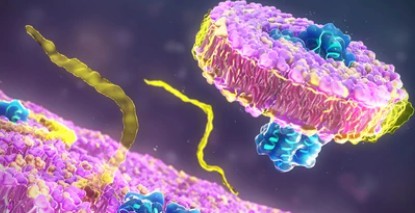Membrane proteins are major therapeutic targets for many diseases, but the discovery of membrane protein antibodies remains a daunting process. The difficulty in the development of membrane protein antibodies lies in the preparation of antigens. Therefore, the development of methods that enhance membrane protein solubilization and stablize membrane protein reconstruction can greatly facilitate the discovery of membrane protein antibodies. Creative Biolabs provides excellent services in antibody production using nanodiscs.

Nanodiscs are disc-shaped phospholipid bilayers used to mimic the natural phospholipid bilayer of cells. They consist of two main structures: a phospholipid and a stabilizing band that binds the phospholipid together, either as a membrane scaffolding protein (MSP) or a synthetic polymer.
MSP particles are artificial membrane scaffolding proteins similar to the ApoA-1 protein, an important component of high-density lipoprotein (HDL) in the human body that plays a crucial role in the reverse cholesterol transport process. It consists of 243 amino acid residues, and cutting off 43 amino acid residues at its N-terminal end can form a soft and flexible MSP particle, which can be used to prepare nanodiscs. There are many synthetic polymers that can be used to prepare synthetic nanodiscs. Synthetic polymers have two functions: firstly, to solubilize cell membranes and secondly to form nanodisc structures around membrane proteins using natural cellular phospholipids.
There are two main types of nanodiscs, MSP nanodiscs and synthetic nanodiscs. The main difference between the two types of nanodiscs is that MSP nanodiscs are composed of MSP proteins and an artificial phospholipid environment, while synthetic nanodiscs are composed of synthetic polymers and natural cell membrane lipids.
In MSP nanodiscs, the MSP provides a hydrophobic surface facing the lipid hydrophobic tail and an external hydrophilic surface. This setup makes the nanodiscs highly soluble in aqueous solutions. Once assembled into nanodiscs, it is possible to keep membrane proteins in solution without contaminants. In general, the size of MSP nanodiscs ranges from 7-17 nm. MSP nanodisc size is determined by the MSP employed, and MSP nanodiscs of the same MSP protein are uniform in size, differing in diameter by only +/- 1 nm.
Synthetic nanodiscs can only be extracted directly from intact cells. The size of synthetic nanodiscs is variable, and the main factor determining their diameter is the size of the membrane protein complex surrounded and stabilized by the nanodisc. If a uniform nanodisk size is required for the synthetic nanodisc complex, the stabilized target membrane protein must be purified using affinity chromatography followed by exclusion chromatography for the nanodisc size.
Both MSP nanodiscs and synthetic nanodiscs can solubilize and stabilize membrane proteins by simulating the cell membrane environment. Therefore, suitable nanodiscs can be selected in the experiment according to the differences between the two nanodiscs. First, the MSP nanodiscs are homogeneous in size, while the synthetic nanodiscs are variable in size. Secondly, the phospholipid composition of MSP nanodiscs can be completely controlled, while the phospholipids of synthetic nanodiscs are composed of natural cell membrane lipids. Finally, the signal of MSP proteins at 280 nm affects the quantitative detection of proteins using absorbance, while synthetic nanodiscs allow the quantitative determination of proteins using absorbance at 280 nm by selecting a suitable synthetic polymer.
Creative Biolabs desires to unlock the treasure trove of knowledge and expertise in membrane protein nanodiscs, bestowing upon you the pivotal insights and extraordinary encounters that shall pave the path of your project with seamless elegance.
All listed services and products are For Research Use Only. Do Not use in any diagnostic or therapeutic applications.